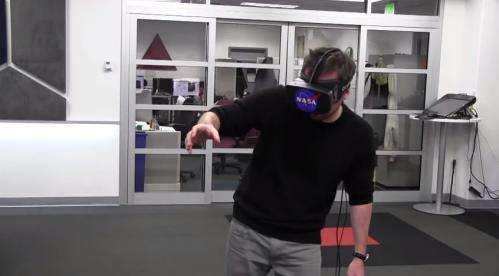December 30, 2013 weblog
Kinect 2 with Oculus Rift gets NASA robotic arm workout

(Phys.org) —NASA engineers like what they see in Microsoft Kinect 2 as they continue to work on space robots. A NASA video released earlier this month shows how it is leveraging a combination of Kinect 2 along with Oculus Rift, the virtual reality head-mounted display, for results that have engineers at NASA's Jet Propulsion Laboratory highly impressed. Looking for optimal ways to maneuver robots in space, team members at JPL talked to Engadget recently about what they discovered in pairing the technologies to control a robotic arm.
Above all they found that using both the Oculus Rift and Kinect brought them more immersive control, (They were among the developers to receive the first preview versions of Kinect 2. They worked with the latter's motion sensor technology, and proceeded to add Oculus Rift's immersive virtual reality, with the goal of manipulating the robotic arm.)
Alex Menzies, a Human Interfaces engineer, described his observations in working with the head-mounted display and Kinect motion sensor. According to Engadget, he said they were able for the first time with consumer-grade sensor to control a robotic limb's entire orientation. Menzies also welcomed the fact that all the visual input was properly mapped to where limbs are in the real world. "It feels very natural and immersive." The Kinect 2 brings more precision and accuracy. Human Interfaces Engineer Victor Luo said it was allowing them to track open and closed states, and rotation of the wrist. "With all of these new tracking points and rotational degrees of freedom, we were able to better manipulate the arm."
The NASA video notes explain that "Using the new Xbox One Kinect sensor they could manipulate a JACO robot arm in realtime. Also, position tracking from Kinect and rotational tracking with Oculus provided a first-person view for the operator."
The JACO arm, with its three fingers and six degrees of freedom, is from the Canadian personal robotics solutions company, Kinova, known for its platforms for rehabilitation and research. The JACO research edition robotic arm is promoted by the company as a product in the"new generation of lightweight portable robotic manipulator."
Next on the JPL agenda will be extending their work to controlling robots such as Robonaut 2; the latter arrived at the International Space Station in 2011 and has performed varied tasks to show how it can function in microgravity. (The ISS is defined as a test bed for technologies that will be vital to human exploration, as NASA explores asteroids and Mars.) The goal is to free up the crew for more critical work, including research. "Our investment in robotic technology development is helping us to bolster productivity by applying robotics technology and devices to fortify and enhance individual human capabilities, performance and safety in space," said Michael Gazarik, NASA's associate administrator for space technology.
More information:
kinovarobotics.com/products/jaco-research-edition/
www.engadget.com/2013/12/23/na … obotic-arm-kinect-2/
www.hi.jpl.nasa.gov/
© 2013 Phys.org





















